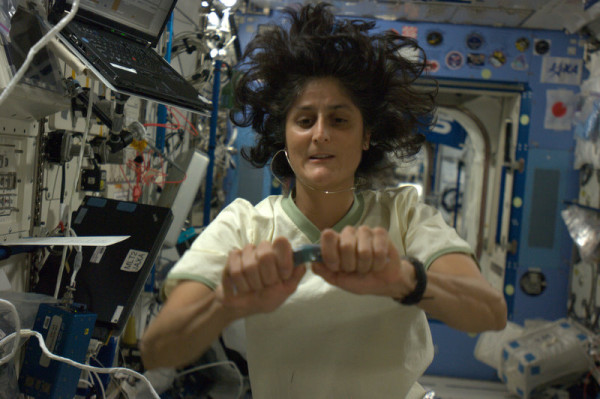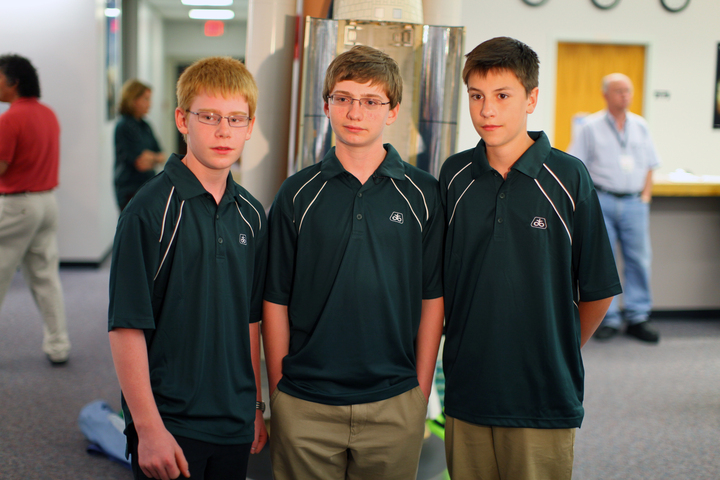
International Space Station Commander Sunita Williams Activating a SSEP Fluid Mixing Enclosure Mini-laboratory (we are not sure which one) CLICK FOR ZOOM
For those following along, the National Center for Earth and Space Science Education and NanoRacks are reporting that Station Commander Suni Williams carried out all scheduled Crew Interaction Activities for day A+6 at 7:12 am EDT, October 17. Two experiments were de-activated. Overviews of the two experiments and their student research teams are provided below.
The SSEP Mission 2 to ISS: Experiment Log was updated yesterday at 7:56 am EDT to reflect these activities.
The de-activated experiments and their student research teams are showcased below.
We are trying to use these updates on experiment operations aboard ISS to ignite discussions in class and family discussions at home. So before getting to the showcase of the two de-activated experiments, here’s some wide-ranging food for thought:)
Be part of the adventure: here’s a challenge for you and your family. The International Space Station is big. It is as big as a football field. And it’s easy to see in the clear night sky. As the station orbits a rotating Earth, the path the Station takes over the surface of Earth – its ground track – likely takes it over your community, and you can see it flying overhead. NASA has a great website that allows you to identify when the International Space Station may be visible in your sky. You enter your nation, and in the case of the U.S., your state and town. It will then display dates and times for a sighting in your area. So take the family out with a pair of binoculars, and see America in space. I’ve provided the link to the NASA website below.
Throw in the Moon too: While you are at it, if you and your children have never seen the Moon using even binoculars, then see if the Moon is out when ISS is flying overhead. Just with binoculars the Moon is an absolutely amazing site. And it is right over your head. I’ve provided the link to a Moon sighting website below.
Things to discuss as a family: The Moon is our nearest celestial neighbor, yet we take it for granted. Here’s something that puts the Moon in a bold new perspective, and is a great subject for a family discussion under the stars. We have discovered significant amounts of water ice on the Moon in deep, permanently shadowed craters near its poles. What can you do with water ice? You can use solar power to liquify it and drink it. You can use solar power to break up the water molecules into hydrogen and oxygen. You can then breathe the oxygen. And you can use solar power to refrigerate the hydrogen and oxygen to temperatures so cold they become liquids. Then when you bring together the liquid hydrogen and liquid oxygen in a controlled way, we call it ROCKET FUEL. That’s what powers the main engines of the Space Shuttle. The water on the Moon? It’s what you need to establish a human colony and set up permanent research bases akin to those in Antarctica. (I need to ask – shouldn’t that be humanity’s next humans-in-space great adventure? Other thoughts – what’s this humans to asteroids stuff all about? And Mars, for the record, is way far. Maybe we should get into the habit of going to granny’s house a couple miles up the street before we venture on a trip across the Continental U.S.)
Finally, I am a firm believer that the Moon is not a moon at all. It is a planet. It belongs to the Sun not the Earth. Why? Because the Sun exerts twice the force of gravity on the Moon as Earth does. The Moon is not orbiting the Earth it is orbiting the Sun (it is falling around the Sun – think about that for a bit). I don’t buy the counter arguments. And hey, if that makes you jump up and down in your seat and want to say something like “How can that be!?” then I invite you to LEAVE A COMMENT BELOW. So maybe we should consider the Earth-Moon system as a binary planet system, that there are again 9 planets in the Solar System, and if you want to see ANOTHER PLANET up close and personal, go look at your Moon with a pair of binoculars. And there goes ISS moving across the sky!
Links:
NASA Human Spaceflight Sighting Opportunities website
Moonrise and Moonset Times at the Old Farmer’s Almanac (planets too)
At Dr. Jeff’s Blog on the Universe, an essay on the Moon, with activities for classroom and at home:
ESSENTIAL QUESTION: How big is the Moon?
If I Could Gift Wrap the Moon
Back to the SSEP experiments update. As reported, two experiments were de-activated on schedule on Crew Interaction Day (A+6), and are therefore now complete. The experiments are listed below:
1. Mission 1 to ISS experiment from Hartford, Connecticut:
How Does Parathyroid Hormone Affect Changes in Bone Mass in Microgravity?
Grades 8 and 12; Annie Fisher Stem Magnet and University High School of Science and Engineering
Co-Principal Investigators: Nick Rapp, Bo-Edward Lawrence, and Samantha Cedeńo
Co-Investigators: Tristan DesRoires, Liam Flannery, and Roshawn Brown
Teacher Facilitators: Dr. Michael Fromerth, Science Teacher, and Keith Sevigny, Biology Teacher
Proposal Summary:
In our experiment we will be testing how microgravity would affect medicine used to treat bone loss (osteoporosis). Since we know that fluids behave differently in microgravity, we hope that by exposing these medicines to an environment with very weak gravity, the medicine might better promote the growth of bones. We are extremely interested in this project because we are aware of the problems osteoporosis has on the astronauts as they travel back in forth into space. We hope to help the studies of osteoporosis, and have an impact on the development of medicines today. When the experiment returns, we will examine the effect of the medicine in microgravity on the growth of bone cells.
2. Mission 1 to ISS experiment from Lake County, Indiana:
The Effect of Microgravity on the Quality and Nutritional Value of the Seed Sprout of a Germinated 92M72 Genetically-Modified Soy Bean
Grades 7 and 8; Highland Christian School
Co-Principal Investigators: Jack Barth and JP Peerbolte
Collaborator: Cameron Zandstra
Teacher Facilitator: Sara Timmer, B.A. Teacher
Proposal Summary:
This experiment will be testing the effect of microgravity on the nutritional value of a 92M72 genetically-modified soy bean sprout. A large struggle for the International Space Station is the cost of shipping food from the Earth. If the astronauts were able to grow their own food on the space station, this cost would be almost eliminated. We believe that the sprout from a soybean would be an excellent nutritional food source for space travel. We will attempt to show that a soybean sprout grown in microgravity retains its nutritional value as compared to one grown on earth.

SSEP Mission 1 researchers Cameron Zandstra, Jack Barth, and JP Peerbolte, Lake County, IN, at Press Site, April 19, 2012 CLICK FOR ZOOM
Co-Principal Investigators Jack Barth and JP Peerbolte, and Collaborator Cameron Zandstra, were down at Kennedy Space Center when their experiment first launched in May 2012 on the first flight of the Mission 1 payload. All three SSEP Student Researchers were at the NASA press site and were interviewed by NASA. Future American researchers Drs. Barth, Peerbolte, and Zandstra are pictured at right at the press site.
We invite you to spread the word about the Student Spaceflight Experiments Program to students, teachers, family members, and organizational stakeholders. To follow SSEP, folks can subscribe to this blog for email notifications of new posts. Anyone can subscribe at the bottom of the right column on the SSEP home page http://ssep.ncesse.org
SSEP is undertaken by the National Center for Earth and Space Science Education (NCESSE) in partnership with NanoRacks LLC. This on-orbit research opportunity is enabled through NanoRacks LLC, which is working in partnership with NASA under a Space Act Agreement as part of the utilization of the International Space Station as a National Laboratory.
SSEP is the first pre-college STEM (Science, Technology, Engineering, and Math) education program that is both a U.S. national initiative and implemented as an on-orbit commercial space venture.





